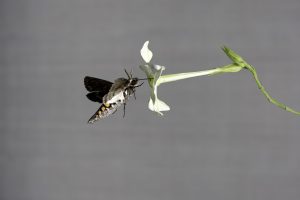
Manduca sexta or the hawkmoth (from Natural Science Foundation)
Moths provide necessary pollination services during the night, which can be negatively impacted by variations in the environment caused by humans such as climate change, air pollution and habitat loss. Artificial light at night is a key factor that leads to disruptions in the physiology and activity patterns of the moths, including nocturnal pollination. Moreover, this human light is known to be directly associated with population declines in nocturnal insects. Previous studies have demonstrated a decrease in motor activity and feeding in moths at high light levels but less is known about how moths interact with flowers at higher light levels. Biologist Tanvi Deora and her team studied the influence of light levels on the efficiency of the hawkmoth, Manduca sexta, in locating nectaries of artifical flowers with their proboscis.

Parts of a flower (from Wisconsin Pollinators)
Hawkmoths utilize visual and mechanical stimuli to manage their flight, examine flowers and find the nectaries while hovering over them. The hawkmoth is known to be most active in dim light, in which they increase their visual sensitivity for better detection of floral patterns. The mechanical stimuli provide information about shape, texture and geometry which are all crucial to find the nectary, as they repeatedly visit the flowers.
The behavioral analysis of this study showed that the proportion of successful visits per moth was greater in lower light levels. Additionally, the exploration time required to locate the nectary during the repeated successful visits was much less at lower light levels. They found moths visited the flowers less frequently and flew further from the center of the flower in higher light levels.

Manduca sexta hovering over a flower (from Max Planck Neuroscience)
This study sheds light on the relative use of different sensory modalities in pollination services. Higher light levels increase the visual information encoded in the stimuli so it was surprising to see that the moths were less successful in feeding on flowers when the light level is high. One reason may be that the higher light levels make several features other than the petals of the flower more visible which may be distracting for the moths. Another explanation could be that the moths’ color preferences shift with shifting light levels. Hawkmoths are able to detect colors in dim light using information about contrast and brightness. A previous study has shown that the hawkmoth has a preference for blue flowers over white ones at higher light levels and flowers with the highest contrast at lower light levels. Their ability to maintain a fully open pupil that provides high sensitivity to contrast enhances their ability to detect colors in dim lights, allowing for successful foraging. But they may approach the same flowers in a different way at higher light levels because of the disruptions in the interpretation of the stimuli.
When multiple sensory modalities are involved in one particular task, success in that task may depend on the relative reliance on those modalities. The authors have also suggested that the visual sensory modality may take over the mechanosensory modality at higher light levels and that the visual feedback is not enough to find the nectary in the flowers. More extensive work on this area is required to support this phenomenon. Predation risk may alternatively be driving the lifestyle of moths in dim light. Many nocturnal and crepuscular animals are known to avoid light in order to avoid being eaten. Therefore the moths may also have been hovering away from the center of the flower to avoid predators.
This study shows that higher light levels can directly impact nocturnal pollination, which has many important implications for the hawkmoth. Many important behavioral processes in an organism are finely tuned to the light-dark cycle. Higher light levels at night could shift the moth’s activity cycle and consequently shift how the insect interacts with its natural surroundings in the long term.
Reference: Deora, T., Ahmed, M. A., Brunton, B. W., & Daniel, T. L. (2021). Learning to feed in the dark: how light level influences feeding in the hawkmoth Manduca sexta. Biology Letters, 17(9). https://doi.org/10.1098/rsbl.2021.0320.
Image links:
Manduca sexta or the hawkmoth – https://www.nsf.gov/news/mmg/mmg_disp.jsp?med_id=73001
Parts of a flower – https://wisconsinpollinators.com/Articles/Nectar.aspx
Manduca sexta hovering over a flower – https://maxplanckneuroscience.org/scent-guides-hawk-moths-to-the-best-fitting-flowers/
